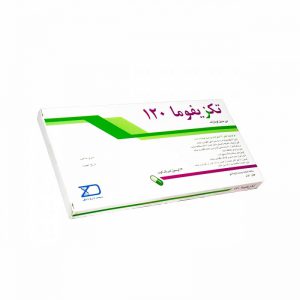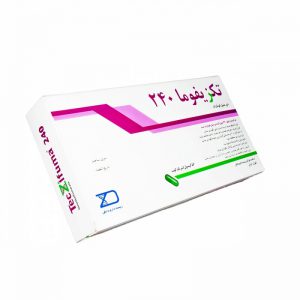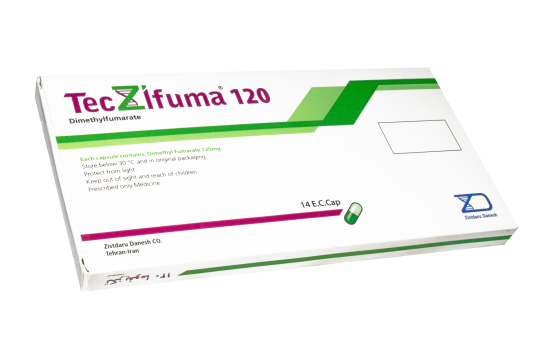1- What is Teczifuma?
Teczifuma is indicated for treatment of patients with relapsing forms of multiple sclerosis, including clinically isolated syndrome, relapsing-remitting disease, and active secondary progressive disease.
- Mechanism of Action
Dimethyl fumarate (DMF) and its active metabolite, monomethyl fumarate (MMF), have been shown to activate the nuclear factor (erythroid-derived 2)-like 2 (Nrf2) pathway, which is involved in cellular response to oxidative stress. The mechanism by which DMF exerts a therapeutic effect in MS is unknown, although it is believed to result from its anti-inflammatory and cytoprotective properties via activation of the Nrf2 pathway.


2- Dosage and Administration
The starting dose for Teczifuma is 120 mg twice a day orally. After 7 days, the dose should be increased to the maintenance dose of 240 mg twice a day orally. Temporary dose reductions to 120 mg twice a day may be considered for individuals who do not tolerate the maintenance dose. Within 4 weeks, the recommended dose of 240 mg twice a day should be resumed. Discontinuation of Teczifuma should be considered for patients unable to tolerate return to the maintenance dose. The incidence of flushing may be reduced by administration of Teczifuma with food. Alternatively, administration of non-enteric coated aspirin (up to a dose of 325 mg) 30 minutes prior to Teczifuma dosing may reduce the incidence or severity of flushing. Teczifuma should be swallowed whole and intact. Teczifuma should not be crushed or chewed and the capsule contents should not be sprinkled on food. Teczifuma can be taken with or without food.
3- Dosage Forms and Strengths
Teczifuma is available as gelatin capsule containing enteric coated microtablets in two strengths of 120 mg and 240 mg. The 120 mg capsules are available in white body and green cap and 240 mg capsules in green body and green cap.
4- Tips before taking Teczifuma
- Who should not take Teczifuma?
In case of any history of hypersensitivity reactions (like angioedema, anaphylaxis, etc.) while taking the medicines containing dimethylfumerate, do not use this product.
- Blood tests prior to initiation of therapy
Obtain a complete blood cell count (CBC) including lymphocyte count, aminotransferase, alkaline phosphatase, and total bilirubin serum levels before initiation of therapy.
- Before taking Teczifuma, tell your doctor or pharmacist if you have/are:
– A history of low lymphocytes
– A history of infection
– A history of liver or kidney disorders
– A history of gastrointestinal diseases
– Pregnant or plan to become pregnant
– Nursing mother
5- Warnings and Precautions
- Dermatitis/irritation: May cause rash, pruritus, or erythema.
- Flushing: Commonly causes mild to moderate flushing (e.g., warmth, redness, itching, burning sensation); flushing generally appears soon after initiation, and improves or resolves with subsequent dosing.
- Gastrointestinal events: GI events (e.g., nausea, vomiting, diarrhea, abdominal pain, dyspepsia) commonly occur with use; GI events generally occur in the first month of use and decrease thereafter.
- Hepatotoxicity: Clinically significant postmarketing cases of hepatic injury have been reported, with an onset ranging from a few days to several months after treatment initiation. Signs/symptoms of hepatic injury, including transaminase elevations >5 times the upper ULN and total bilirubin elevations >2 times ULN have been observed. Liver function test abnormalities resolved upon discontinuation. Monitor liver function tests prior to treatment initiation and during treatment.
- Hypersensitivity reactions: Anaphylaxis and angioedema may occur after the first dose or at any time during treatment.
- Infections: Serious cases of herpes zoster (e.g., disseminated, ophthalmicus, meningoencephalitis, meningomyelitis) have been reported; may develop any time during treatment. Other serious opportunistic infections have occurred, including viral (e.g., Cytomegalovirus, herpes simplex, West Nile), fungal (e.g., Aspergillus, Candida), and bacterial (e.g., Listeria monocytogenes, Mycobacterium tuberculosis, Nocardia), in patients with and without lymphopenia. Consider temporary interruption of therapy until infection has resolved. In high-risk populations or in countries with high tuberculosis burden, screen for latent infections (e.g., hepatitis, tuberculosis) prior to initiating therapy. For patients who screen positive for latent infections, consult infectious disease or other specialists (e.g., liver specialists) regarding treatment options before initiating therapy.
- Lymphopenia: Decreased lymphocyte counts may occur. The risk for lymphopenia is not reduced over time. A decline in absolute lymphocyte count (ALC) typically occurs in the first year of treatment and stabilizes, though an early ALC drop has been associated with later development of severe, prolonged lymphopenia. Monitor CBC and signs of infection. Due to a potential for delayed lymphocyte recovery following treatment interruption or discontinuation, monitor lymphocyte counts until lymphopenia is resolved.
- Proteinuria: In clinical trials, proteinuria was reported at a slightly higher incidence than that observed with placebo; significance of these findings is unknown.
- Progressive multifocal leukoencephalopathy: Cases of progressive multifocal leukoencephalopathy (PML) due to the John Cunningham (JC) virus, including fatality, have been reported. Reported risk factors include persistent lymphopenia, prior immunosuppressant use, increased age, sarcoidosis, and cancer history. However, cases have been reported in patients who were not immunocompromised and had no prior exposure to immunosuppressive drugs, including natalizumab. Severe, long-standing lymphopenia is a primary risk factor for PML, and the majority of PML cases occur in patients with lymphocyte counts <800/mm3. Symptoms progress over days to weeks and may include progressive weakness on one side of the body or clumsiness of limbs, vision disturbances, and mental status changes. Cases of PML have been diagnosed based on MRI findings and the detection of JC virus DNA in the CSF without specific PML signs/symptoms. Monitoring with brain MRI for signs that may be consistent with PML may be beneficial and allow for an early diagnosis of PML.
6- Common Adverse Effects of Teczifuma
Very common (>10%):
Flushing
Abdominal pain
Nausea
Diarrhea
Infection
Common (1% to 10%):
Erythema of skin
Pruritus
Skin rash
Albuminuria
Dyspepsia
Vomiting
Lymphocytopenia
Increased serum aspartate aminotransferase
Rare (Less than 1%):
Transient eosinophilia
7- Use in Specific Populations
Pregnancy:
Information related to the use of dimethyl fumarate in pregnancy is limited. In general, disease-modifying therapies for multiple sclerosis are not initiated during pregnancy, except in females at high risk of multiple sclerosis activity. When disease-modifying therapy is needed in these patients, other agents are preferred.
Lactation:
It is not known whether this drug is excreted in human milk. Because many drugs are excreted in human milk, caution should be exercised when Teczifuma is administered to a nursing woman.
Pediatric Use:
Safety and effectiveness in pediatric patients have not been established.
Geriatric Use:
Clinical studies of Teczifuma did not include sufficient numbers of patients aged 65 and over to determine whether they respond differently from younger patients.
8- Teczifuma Drug Interactions
Tell your doctor if you use other drugs or even herbal drugs or supplements.
- Diroximel Fumarate: Teczifuma may enhance the adverse/toxic effect of Diroximel Fumarate. Risk X: Avoid combination
- Monomethyl Fumarate: May enhance the adverse/toxic effect of Teczifuma. Risk X: Avoid combination
- Vaccines (Live): Teczifuma may enhance the adverse/toxic effect of Vaccines (Live). Specifically, Teczifuma may increase the risk of vaccinal infection. Teczifuma may diminish the therapeutic effect of Vaccines (Live). Risk C: Monitor therapy
9- Active Ingredients of Teczifuma
Dimethyl Fumarate (white powder)
10- Teczifuma Storage and Handling
– Store below 30˚C and in original packaging.
– Protect from light.
– Keep out of sight and reach of children.
– Prescribed only medicine
11- Nurse-Patient Helpline Team
You can contact Drugs Expert Consultation Center at 0935 220 3041-4 to get answers to your inquiries and also get to know nursing support centers in your city. Expert Consultation Center is always ready to answer the questions of our valued customers.



